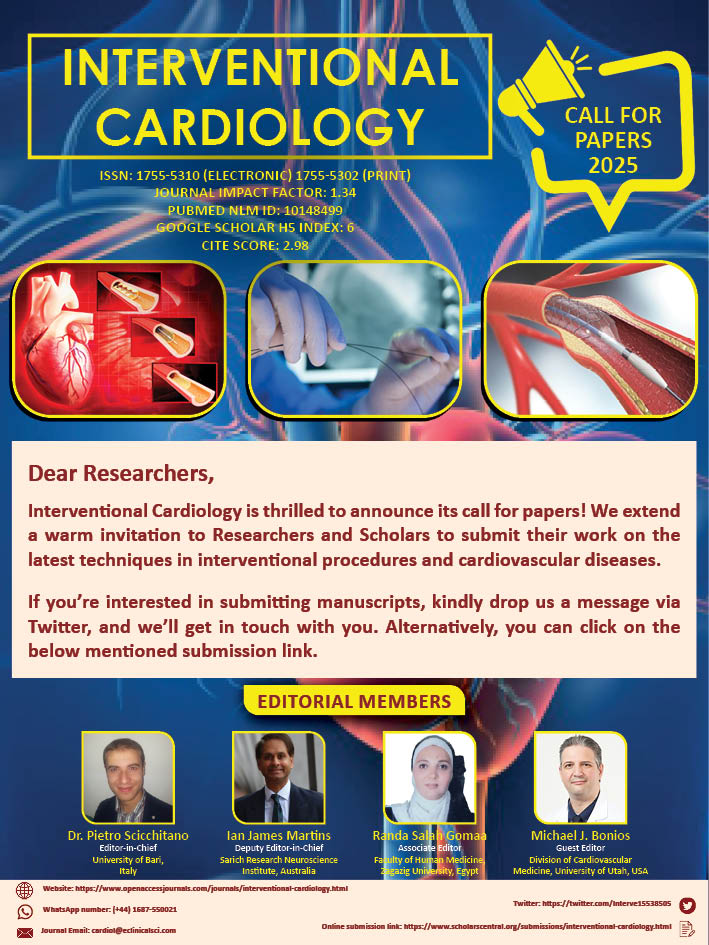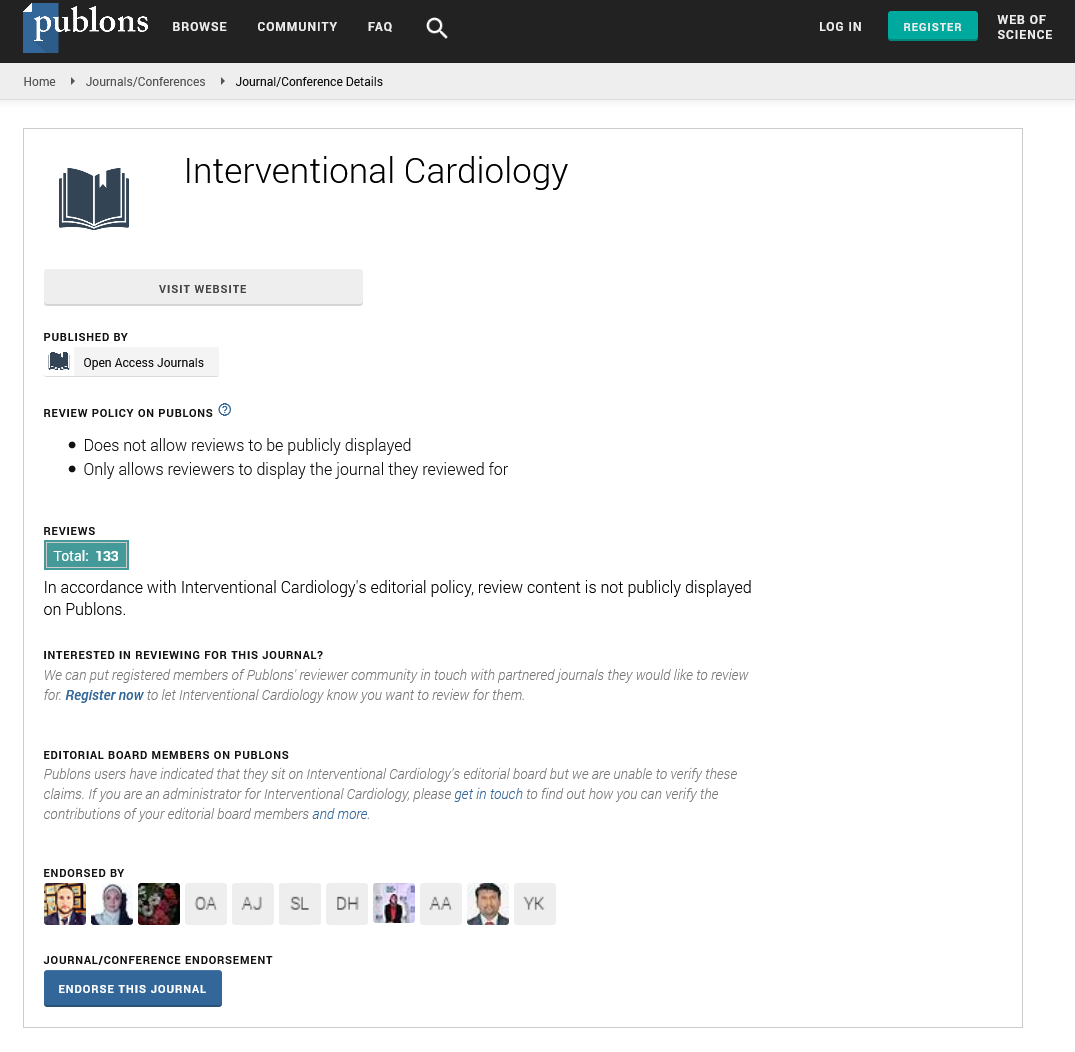Short Communication - Interventional Cardiology (2025) Volume 17, Issue 1
Are We Missing Something? The Hidden Potential of Apical Rocking and Septal Flash in Cardiac Resynchronization Therapy
- Corresponding Author:
- Dragoș Constantin Cozma
Doctoral School, “Victor Babeș” University of Medicine and Pharmacy, 300041 Timișoara, Romania
E-mail: dragos.cozma@umft.ro
Received date: 01-Jan-2025, Manuscript No. FMIC-24-162181; Editor assigned: 03-Jan-2025, PreQC No. FMIC-24-162181 (PQ); Reviewed date: 17-Jan-2025, QC No. FMIC-24-162181; Revised date: 24-Jan-2025, Manuscript No. FMIC-24-162181 (R); Published date: 31-Jan-2025, DOI: 10.37532/1755- 5310.2025.17(1).959
Abstract
Cardiac Resynchronization Therapy (CRT) is known as a cornerstone in the therapy of Heart Failure (HF) patients with electrical dyssynchrony. However, patient selection remains a challenge, as one-third of patients do not respond to CRT. The echocardiographic evaluation of mechanical dyssynchrony is crucial for selecting appropriate patients. Our review focuses on two echocardiographic parameters, Apical Rocking (ApR) and Septal Flash (SF), which can provide insights into the complex mechanisms of cardiac dyssynchrony in HF patients. The article provides insights into the definitions, mechanisms, clinical significance, and limitations of these two echocardiographic parameters, intending to present a comprehensive overview of their potential role in optimizing CRT patient selection and improving clinical outcomes.
Description
HF is a complex clinical syndrome affecting nearly 64 million people worldwide [1]. In European countries, the prevalence of HF is estimated at 1.89%, with an in-hospital mortality rate between 7%-11% [2], while in the United States, the prevalence is 2.4%, with over 1 million hospitalizations for decompensated HF annually [3]. Interestingly, the incidence and mortality of HF in Japan, once comparatively low, have increased substantially, and it has been reported that approximately 1 to 2 million patients have chronic HF, with a prevalence of around 6.5% for patients of all ages, meaning that nearly 170,000 patients die because of the burden of HF [4,5]. This may be due to the rapid aging of the population and a Western type of lifestyle, leading to the appearance of coronary artery disease.
CRT is a well-established treatment for HF patients with a severely reduced ejection fraction (LVEF<35%) and a QRS duration greater than 130 ms who remain symptomatic despite Guideline-Directed Medical Therapy (GDMT) [6]. Contrary to the substantial progress in HF care due to CRT, one-third of patients do not respond to CRT, and patient selection still represents a critical challenge. Current guidelines primarily rely on QRS duration and Left Ventricular Ejection Fraction (LVEF) for the CRT inclusion criteria. Yet, these parameters may insufficiently represent the complex mechanisms of mechanical dyssynchrony that contribute to poor cardiac function in HF patients.
Echocardiography is a key tool in evaluating mechanical dyssynchrony, providing information about regional wall motion abnormalities and dyssynchronous contraction patterns characteristics to HF patients. The echocardiographic evaluation of the Left Ventricular (LV) mechanical dyssynchrony before CRT, regardless of QRS duration or LVEF, may improve patient selection and identify patients who may benefit from CRT [7,8]. Our review focuses on ApR and SF, two separate yet possibly interconnected parameters of mechanical dyssynchrony, aiming to clarify their definitions, underlying mechanisms, clinical utility, and limitations.
Apical rocking
ApR is defined as the rocking motion of the LV apex during systole. The underlying mechanism of ApR is thought to be related to the heterogeneous activation and contraction patterns in the dyssynchronous heart. It is characterized by an initial systolic movement of the apex toward the base of the heart, followed by a subsequent movement in the opposite direction [9,10]. Some studies have shown that patients with a more prominent motion of ApR may be more likely to benefit from CRT, highlighting its potential role in patient selection [11,12].
Septal flash
Left Bundle Branch Block (LBBB) physiology involves a right-toleft depolarization sequence, leading to premature contraction of the Right Ventricle (RV) and subsequent systolic movement of the interventricular septum towards the LV, resulting in SF [13,14]. Basically, SF is the early, transient, rapid systolic motion of the interventricular septum towards the LV that occurs before the start of the overall septal contraction [15], and it may be used as a predictor for response in CRT patients [16].
Apical rocking and septal flash: two views of the same systole?
ApR and SF were associated with lower all-cause mortality and HF hospitalization [17]. Both parameters appear to be independent echocardiographic findings, but they may represent different components of the same underlying pathophysiological mechanism. ApR and SF demonstrate regional wall motion abnormalities and dyssynchronous contraction patterns. ApR indicates the delayed contraction of the basal segments, while SF indicates the early contraction of the RV and its effect on septal motion. Both may coexist in the same patient, signifying an increased degree of mechanical dyssynchrony. However, there is no universal consensus in quantifying these two echocardiographic parameters.
A comprehensive echocardiographic screening, including the evaluation of both ApR and SF, may offer a more thorough understanding of mechanical dyssynchrony and ultimately lead to better clinical outcomes.
Clinical implications and future directions
ApR and SF represent relevant echocardiographic parameters for evaluating mechanical dyssynchrony and might improve traditional electrical criteria. However, standardization in the evaluation of both parameters is needed to improve the reproducibility and comparability of these parameters, either independently or in coexistence. Further studies are needed to quantify ApR and SF, to evaluate the additional value of ApR and SF alongside existing CRT selection criteria, and to determine the impact of integrating ApR and SF into clinical practice on CRT response and patient outcomes. A multimodal approach combining electrical, echocardiographic, and other imaging data could provide a complete evaluation of dyssynchrony and result in personalized CRT strategies.
Conclusion
ApR and SF are two different yet possibly associated echocardiographic parameters of mechanical dyssynchrony. They provide significant insights into the complex pathophysiology of LV in HF patients and may be crucial in improving CRT patient selection. Although additional research is required to optimize their evaluation methods and validate their clinical utility, ApR and SF are promising parameters for improving the outcomes of HF patients who are undergoing CRT.
References
- James SL, Abate D, Abate KH, et al. Global, regional, and national incidence, prevalence, and years lived with disability for 354 diseases and injuries for 195 countries and territories, 1990-2017: A systematic analysis for the global burden of disease study 2017. The Lancet. 392(10159):1789-1858 (2018).
- Rosano GM, Seferovic P, Savarese G, et al. Impact analysis of heart failure across European countries: An ESC‐HFA position paper. ESC Heart Fail. 9(5):2767-2778 (2022).
- Savarese G, Becher PM, Lund LH, et al. Global burden of heart failure: A comprehensive and updated review of epidemiology. Cardiovasc Res. 118(17):3272-3287 (2022).
- Shiba N, Shimokawa H. Chronic heart failure in Japan: Implications of the CHART studies. Vasc Health Risk Manag. 4(1):103-113 (2008).
- Zhang L, Ono Y, Qiao Q, et al. Trends in heart failure prevalence in Japan 2014-2019: A report from healthcare administration databases. ESC Heart Failure. (3):1996-2009 (2023).
- Michowitz Y, Kronborg MB, Glikson M, et al. The ‘10 commandments’ for the 2021 ESC guidelines on cardiac pacing and cardiac resynchronization therapy. 42(42):4295 (2021).
- Yu CM, Bleeker GB, Fung JW, et al. Left ventricular reverse remodeling but not clinical improvement predicts long-term survival after cardiac resynchronization therapy. Circulation. 112(11):1580-1586 (2005).
- Yu CM, Fung WH, Lin H, et al. Predictors of left ventricular reverse remodeling after cardiac resynchronization therapy for heart failure secondary to idiopathic dilated or ischemic cardiomyopathy. Am J Cardiol. 91(6):684-688 (2003).
- Ghani A, Delnoy PP, Ottervanger JP, et al. Apical rocking is predictive of response to cardiac resynchronization therapy. Int J Cardiovasc Imaging. 31(4):717-725 (2015).
- Ghani A, Delnoy PP, Smit JJ, et al. Association of apical rocking with super-response to cardiac resynchronisation therapy. Neth Heart J. 24(1):39-46 (2016).
- Hsu JC, Solomon SD, Bourgoun M, et al. Predictors of super-response to cardiac resynchronization therapy and associated improvement in clinical outcome: The MADIT-CRT (multicenter automatic defibrillator implantation trial with cardiac resynchronization therapy) study. J Am Coll Cardiol. 59(25):2366-2373 (2012).
- Stankovic I, Prinz C, Ciarka A, et al. Relationship of visually assessed apical rocking and septal flash to response and long-term survival following cardiac resynchronization therapy (PREDICT-CRT). Eur Heart J Cardiovasc Imaging. 17(3):262-269 (2016).
- De Boeck BW, Teske AJ, Meine M, et al. Septal rebound stretch reflects the functional substrate to cardiac resynchronization therapy and predicts volumetric and neurohormonal response. Eur J Heart Fail. 11(9):863-871 (2009).
- Walmsley J, Huntjens PR, Prinzen FW, et al. Septal flash and septal rebound stretch have different underlying mechanisms. Am J Physiol Heart Circ Physiol. 310(3):H394-H403 (2016).
- Calle S, Delens C, Kamoen V, et al. Septal flash: At the heart of cardiac dyssynchrony. Trends Cardiovasc Med. 30(2):115-22 (2020).
- Gąsior Z, Płońska-Gościniak E, Kułach A, et al. Impact of septal flash and left ventricle contractile reserve on positive remodeling during 1 year cardiac resynchronization therapy: The multicenter ViaCRT study. Arch Med Sci. 12(2):349-352 (2016).
- Bustillo SR, Durán AG, Fernández AC, et al. Prognostic value of apical rocking and septal flash after cardiac resynchronization. REC: CardioClinics. 58(1):25-31 (2023).

